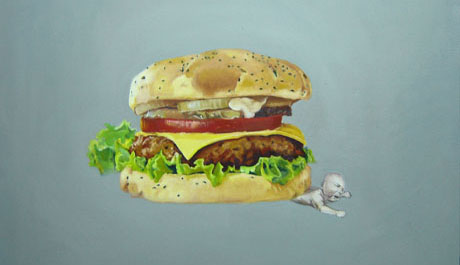 |








  
|
 |
 |


 |

'Six 21st-Century Chinese Neo-Pop Artists'
by Richard Speer
ARTnews, April 2008, p. 149
Return to Press

Adopting a Pop esthetic, the six artists of this show variously celebrated and critiqued the
transformation of China's economic and social landscape. This pairing of style and theme proved
fruitful, playing up Pop's facility for communicating a wry detachment from, and simultaneous
breathless engagement with, consumerism.
Painter Kang Can positions baby boys - coveted in one-child Chinese families - on the verge of jeopardy.
One crawls along an enormous burning cigarette, another teeters on the lip of a beer mug, and one
struggles to crawl out from under an artery-clogging jumbo cheeseburger. Set in front of flat backgrounds,
the guileless babes seem to stand in for national traditions endangered in the infancy of China's economic
boom.
Li Bo deploys similarly flat backgrounds in paintings of objects lined up side by side, regardless of
proportion: an AK-47 the same size as a potted flower, a schoolgirl next to a human heart. These create
a pictographic commentary on hot-button issues facing the country: human-rights violations, drug trafficking,
prostitution, and organ harvesting.
Taking a different tack, two artists juxtapose imagery from historical and modern China, not always
effectively. Lu Peng's gouaches on rice paper tend toward an unvaried palette and compositional fussiness
that detract form their impact. Liu Yan's more spacious approach serves her mixed-media works well; punk
rockers and thong-clad strippers mix with traditional Chinese domestic scenes, as in the nudgingly provocative
Man's World (2007).
Yang Na and Xiong Lijun contributed the show's most exuberant, least conceptual pieces. Awash in hot pinks
and acid greens, Xiong's portraits of doe-eyed glamour girls with pouty lips and overzealous mascara are
especially garish. The works at once convey the vacuity of pop culture and the continuing seductiveness
of Pop art.

|